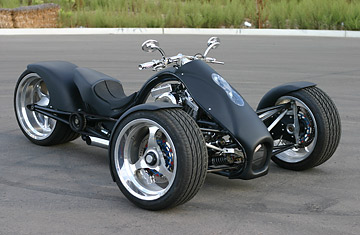
The TriRod F3 Adrenaline
There's nothing quite like the adrenaline rush of speeding down a freeway on a Harley-Davidson V-Twin motorcycle. But roughriders who have leaned a little too far into a sharp curve and felt their knees skim the pavement know that this brand of adrenaline is not for everyone. Now motorcycle manufacturers are catching on, revving up the market for bikes with two wheels in the front and one in back (traditionally, bikes with three wheels — known as trikes — have sported the reverse, with the two wheels in the back). Companies like Bombardier and Piaggio are targeting the safety-conscious motorcycle consumer with bikes that boast greater stability without losing that dash of adrenaline. Bombardier has long been a trailblazer in the business of outdoor-adventure vehicles like snowmobiles, Sea-Doos and all-terrain vehicles (atvs), and now it is looking to conquer the open road with its Can-AM Spyder, a three-wheel cross between a motorcycle and an atv that retails for $15,000.
While the wheels have no tilt, riders can still enjoy the open-air feeling of a motorcycle. For a little more horsepower, TriRod Motorcycles has created the F3 Adrenaline, which comes equipped with Penske racing shocks, Pirelli tires and a 120-cu.-in. (1,970 cu cm) racing motor. At $55,000, the F3 appeals to the thrill-seeking motorcycle enthusiast looking for a little more safety without losing the race-car aesthetic and machinery. "There's an older group of people who may want something different. You have a tipping factor when there is just one wheel in the front," says Kent Harle, a longtime rider who has owned more than 100 motorcycles and has ridden the F3. "It handles great and has the appeal of an American V-Twin." While many of these new three-wheelers don't lend themselves to the typical motorcycle joyride, Piaggio's MP3 500 is the only gas-powered bike in the category that provides tilt in the tires. In terms of design, this $8,900 version isn't the most impressive in the category, but it has the most potential as a practical commuting vehicle. Last year the MP3 250 model became Piaggio's best-selling scooter in the U.S. For the environmentally aware consumer, Vectrix is coming out with the electric V3 later this year. Like the Piaggio, the V3 has tilt in the wheels. It is better suited to short-distance commutes, because it gets about 35 to 55 miles (56 to 89 km) per charge. The V3's locking system on the front tires is automatic, so that "it's for newer riders or people working who need to use their hands," says Jeff Morrill, chief marketing officer for Vectrix USA. At $13,990, the V3 is a great form of transportation for those looking for a safe, clean way to commute.
In contrast, Aptera founder Steve Fambro created the aerodynamic Type 1 to provide consumers with an electric vehicle that is safe and fuel efficient, capable of traveling up to 120 miles (190 km) per charge while storing objects as large as a surfboard. Even though this $27,000 trike is classified as a motorcycle, its far-out design makes it look more like something from outer space. As Fambro puts it, "If you're designing a series of vehicles for the future of transportation and you know that energy is scarce, why would you not change your basic design premise?"